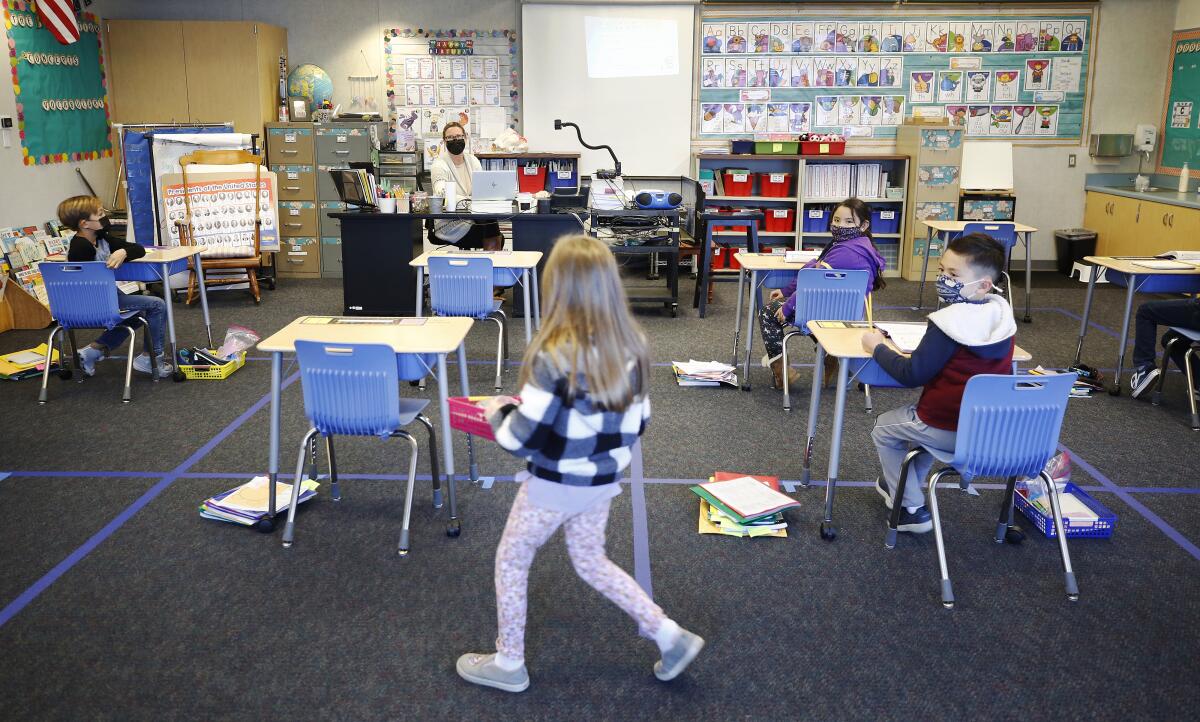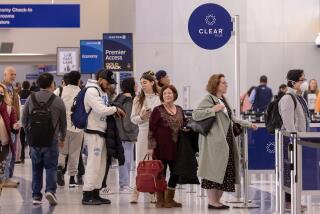Here’s the CDC’s advice for reopening schools safely

- Share via
The U.S. Centers for Disease Control and Prevention released new guidelines Friday for how to open K-12 schools safely in a bid to help students across the nation resume in-person learning before the end of the 2020-21 school year.
The newly released guidance stresses five key mitigation strategies that, layered with one another, provide teachers, staff and students significant protection from the coronavirus that causes COVID-19, said Dr. Rochelle Walensky, director of the CDC.
The strategies are universal mask wearing at school, maintaining at least six feet of social distance, frequent hand washing, cleaning and ventilating school facilities, and contact tracing, isolation and quarantine protocols.
“While each of these five strategies are important to reducing spread of COVID-19, the CDC is prioritizing the first two,” Walensky said. “Correct use of masks should be required of all teachers, students and staff, and physical distancing including cohorting or podding with a small group of students.”
The agency also described a four-tiered system for reopening based on the number of daily new cases in a community over the last seven days, and the percentage of tests that came back positive over the same time period. To be in the lowest tier would require a community to have fewer than 9 new cases per 100,000 people in the last seven days and a positive-test rate of less than 5%.
The new recommendations are not a mandate, Walensky said.
“I want to be clear: with the release of this operational strategy, the CDC is not mandating that schools reopen,” she said. “These recommendations simply provide schools with a long-needed road map of how to open schools safely in a community.”
How these new guidelines will affect school reopenings in California, however, remains to be seen. The state’s guidelines for reopening schools are currently more restrictive than what the CDC is recommending.
In addition, United Teachers Los Angeles, the union that represents teachers, librarians, nurses and counselors in L.A. Unified, the nation’s second-largest school district, does not want employees to return unless they are vaccinated.
Though the CDC encouraged states to prioritize teachers and school staff for vaccinations, it stopped short of saying they were necessary to reopen schools safely.
“Vaccinations are one of those layers of mitigation we believe will help, but the science has demonstrated that schools can reopen safely prior to all teachers being vaccinated,” Walensky said.
Gov. Gavin Newsom said the new guidance is similar to guidelines already in place in California, although he did not endorse replacing the state’s guidance.
“What the CDC put out is very consistent with the message that we’re putting out: We can safely reopen schools for our youngest kids, and we can do so with transparency and accountability,” he said.
Reopening schools has been a fraught topic for President Biden, who had strong support from teacher unions during his campaign but also pledged to get more kids back into their classrooms during the pandemic.
His administration is focused on reopening the majority of elementary and middle schools by April 30, the end of his first 100 days in office. White House Press Secretary Jen Psaki said earlier this week that a school would be considered open if it provided only one day of in-person instruction per week, then clarified the next day that Biden wouldn’t be satisfied with that.
“The president will not rest until every school is open five days a week,” Psaki said. “That is our goal. That is what we want to achieve.”
In a statement, Biden said the CDC guidelines were an important step toward getting kids back in school, and he pushed for more funding for education as part of his $1.9-trillion stimulus package.
“These needs cost money. But the cost of keeping our children, families and educators safe is nothing when compared with the cost of inaction,” Biden said.
U.S. Rep. Kevin McCarthy (R-Bakersfield), the House minority leader, praised the new guidance but criticized the Biden administration for failing to push harder to reopen schools.
“Families and students deserve better,” he said in a statement. “They need iron-clad assurances that their children will be able to get back into the classroom environment that offers the best education model.”
Getting students back to in-person learning has been a challenge in California.
Under the state’s current rules, elementary schools can reopen when the seven-day average of new infections in a county falls below 25 daily cases per 100,000 residents. All students in grades seven through 12 can return to in-person classes when the case rate falls to 7 cases or fewer per 100,000. (Each county’s rate is adjusted up or down depending on the number of tests conducted in a county.)
Since the system went into effect in August, L.A. County has met the seven-case threshold for only one week. (At that time, the rate had to remain at that level for at least two weeks for schools to reopen.)
Cases, however, are dropping: The 25-per-100,000 standard could be achieved as early as next week. Once that happens, the county would then have to remain at that level for five additional days. Thus, a best-case scenario could have elementary campuses eligible to reopen in about two weeks.
Whether schools open or not is a local decision, said L.A. County Public Health Director Barbara Ferrer. School systems in smaller, suburban and more affluent areas are generally more willing to reopen quickly — and infection rates in their communities are relatively low.
School systems that serve low-income communities, where infection rates and deaths have been high, are more reluctant to reopen.
The availability of vaccines has been a particular sticking point in California.
L.A. Unified Supt. Austin Beutner has called vaccines a “critical piece” for reopening, although he has stopped short of saying they must be provided. Beutner also has said that the virus is too widespread in L.A. County at the moment for campuses to fully reopen in a way that adequately protects students and staff.
But campuses are ready, he said, when it comes to establishing safety protocols and performing necessary retrofitting.
The decision to delegate Friday’s announcement to the Centers for Disease Control and Prevention is another example of how Biden is attempting to move past the partisanship that has characterized the country’s response to the pandemic. Former President Trump routinely demanded that schools reopen, even before there was a clear understanding of whether classrooms could become hot spots, and Democrats recoiled from the suggestion.
When the academic year started in the fall, schools were more likely to be open if they were in Republican communities. In fact, whether children returned to the classroom was more closely correlated to partisanship and the strength of teachers unions than COVID-19 transmission rates in the community.
Those opened schools have provided scientists with actual data on the spread of illness among students and staff.
A growing body of research now suggests that schools that implement mitigation strategies such as masking, frequent hand washing, and maintaining six feet of distance between students and staff can reopen safely, even in areas where positivity rates are high and before teachers are vaccinated.
In one widely cited study of 11 North Carolina school districts with more than 90,000 students and staff practicing the same mitigation strategies recommended by the CDC, researchers identified 773 coronavirus infections among teachers, students and staff in the first nine weeks of the fall semester. Of those infections, 32 appeared to originate at school — and none of the cases involved a student transmitting the virus to an adult.
“Multiple scientific studies show these mitigation strategies work outside of school buildings, so there is no reason to believe they wouldn’t work in school buildings,” said Dr. Kanecia Zimmerman, a professor of pediatrics at Duke University School of Medicine who worked on the study.
The authors also found that as long as these strategies were in place, in-school transmissions remained low, even in districts where the virus was widespread.
Another study of 17 K-12 schools in Wisconsin found that even in communities where up to 40% of the population tested positive for infection, transmission in schools that followed strict safety protocols was significantly lower than in the community at large.
Among 191 cases of COVID-19 identified among students and school staffers in this study, seven were found to have originated at a school, and all of those were among students. No teachers or other staff members contracted infections at school, the researchers found.
Yet another study in Mississippi found that children who attended in-person classes were no more likely to be infected with the coronavirus than kids who did not come to school. However, kids who tested positive for the virus were more likely to have attended gatherings with people outside their household, had visitors in their home, or had a play date with other children compared to kids who tested negative.
“People are getting infected anyways, whether schools are open or closed,” Zimmerman said. But open schools could provide “an environment where there are guidelines and rules in place to prevent transmission at really high rates,” she said.
Rita Burke, assistant professor of clinical preventive medicine at USC, said the new guidance reinforces what public health experts have been saying for a while.
“It essentially says wearing masks, socially distancing and washing hands work. Testing works. If we can put these in place in our schools, then we can open safely and, most importantly, stay open,” she said.
However, even with the new CDC guidelines, not everyone is convinced.
“There is no safe reopening of schools until there has been progress made on vaccinations, and that is the bottom line,” said Odis Johnson, executive director of the Johns Hopkins Center for Safe and Healthy Schools.
“I can’t overstate how many teachers we’re losing because of the fear of infection. So, while some people are thinking how do we safely reopen schools, I’m thinking how does the school function when school is reopened and half the teachers don’t show up,” he said.









